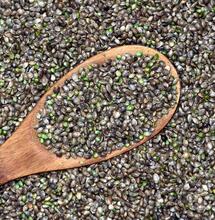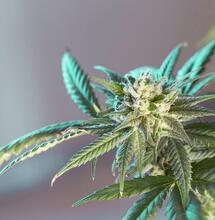Better Buds with Mr. Bill: Yellow Leaves and Too-Large Pots?

Mr. Bill, our plant fix-it guy, invites you to ask him questions so that you can achieve better yields.
Mr. Bill, our plant fix-it guy, invites you to ask him questions so that you can achieve better yields.
|
Having too-strong lamps or lights that are too far from the seedlings can cause stretching |
Mr. Bill is ready to assist you by drawing upon over twenty-eight years of active grow shop experience - including answering growers' questions about the hydroponic industry. Before Mr. Bill opened his first store he worked in the agricultural industry for five years, growing tobacco.
Hello Mr. Bill,
I have searched for answers by reading all day but can't seem to get any closer to any answer. Maybe you are the person to ask....
I am a beginner grower, but I have spent a great deal of money on this. I got a Bud Box 100 cm by 100 cm by 180 cm (39.4" by 39.4" by 70.9"), with all its accessories, for an easier way to get some big buds. The box also came with a 600-watt HPS and a 600-watt MH.
My conditions in the tent: the lamp is about 45 cm (17.7 inches) above the plants. It keeps the heat in the tent stable at around 28º C (82.4º F).
My thought is that the problem seems to be that I have placed the plants in a too-big growth space, four-gallon buckets. My plants started to slope, slim and bent, and turn light yellow.
I have looked at thousands of pictures, all from too much nitrogen to
over-watering. I think they look very alike; it's hard to tell for an amateur.
I noticed that I didn't have any drainage in the buckets so I drilled a couple of holes in the bottom;
the soil is now hard and damp. Should I wait for it to dry out or maybe transplant into better soil with cocos and sand?
I don't want to waste the other five seeds and have the same thing happen.
By the way, the last picture is of strawberries that I cultivate at the same time. They also seem to be sick.
Thanks,
Nick
Hello Nick,
Go with your instincts. Yes, the pots are probably too big. One of the main issues with this is that you can easily over-water the little ones, which compacts the soil and crushes or suffocates the roots. You also waste nutrients in the empty soil and can burn the babies with mature plant levels of nutrients. Yellow leaves are probably a lack of plant food.
Always start your seeds in peat pots, peat plugs or rock-wool cubes, as this protects the roots when transplanting. Additionally, seedlings should be potted in special seedling soil, as babies require far less nutrient than mature plants. Thus your feeding schedule and nutrient levels, plus the lamp strength, soil type and pot size, should reflect the age of the plant.
The soil that you should be using after the seedling phase is the same type used by organic tomato growers; BioBizz makes a good one called All-Mix. Look for organic, sterilized, supplemented soil that provides good drainage. Mixing your own is not as easy to do as it might seem, as it is very difficult to get it thoroughly combined. Sand is good for drainage but too much leads to the same compacting problems that you now have.
|
Seedlings generally require at least four internodes before transplanting |
From the pictures, I would suggest that it is best for you to start over. Start new seeds in between paper towels; once sprouted, place each seed into a cube, pellet or peat pot with the root tip pointing horizontally (about a quarter-inch below the soil or 0.635 cm). Keep two T5 lights about six inches (15.24 cm) above the soil; as your plants grow, keep raising the lights until the plants are four to six inches tall (roughly ten to fifteen cm) and transplant under your MH light, keeping the light about eighteen to twenty-four inches (forty-six to sixty-one cm) from the growing tips. Feed with your nutrients every time you water, unless the plant food manufacturer makes a different recommendation. Once the plants are six weeks old, or auto plants begin flowering, place them under HPS light.
Protect Your Cannabis Seedlings
Germinating and propagating seedlings requires a lower temperature than what you are using -- it would be safer at around 20º to 25º C (68º to 77º F) -- but also pretty high humidity in comparison with older plants. Think: the older the plant, the less humidity you need. It is best to begin the babies in a propagator (the plastic ones with a see-through, domed lid are best, but you could theoretically build one yourself) that is kept clean and watered regularly, as needed. If the condensation inside the dome is even and very tiny droplets, looking like frosted glass, you are on the right track. If, however, the condensation appears as larger beads of water, you must open the dome and wipe it dry with a clean cloth every time that happens, or the little ones can die from a type of rot called 'damping off' -- this is the easiest way to lose young seedlings or clones and is very common.
Keep the dome under fluorescent lights or in a windowsill, making sure that all the babies receive equal light exposure. It is best to start new seeds under a T5 florescent light - the color spectrum is better and the lamp is not as strong as grow lights. Keep florescent tubes about three inches (7.62 cm) away from growing tips. Your plants are reaching for the light, which indicates that you either do not have the light on for long enough or that the light is too far away from the plants.
The little ones can withstand eighteen hours of light; some people give them twenty-four hours but you need to know what you are doing if you want to push them like that. HPS and MH lights are too powerful for young babies and can burn them or make them stretch, like yours have already shown. Prop them up, if needed, using clean plastic sticks or something similar. Be careful with plant clips, twist ties or anything like that and maybe only use those on older plants, being cautious not to strangle the stem. Maintain humidity levels at around eighty to ninety percent (which, as previously mentioned, is way too high for mature plants - especially if they are fully flowering).
When seedlings grow up straggly and skinny, they may die; if your plants live until they have at least four sets of branches or internodes, then you can place soil around the stem and new roots will sprout from the stalk.
Transplant Accordingly
Once your plants are big enough (say, four internodes or so) you can transplant them into a slightly larger pot (two liters to four liters to six liters, etc., if you are limited to a grow tent) and then put them under a real grow lamp. Some folks grow lots of plants in a square meter and never go above a liter pot; re-pot as needed but do not make extremely large jumps in size.
If you started from seeds then you will need to grow these plants until they are about six weeks old. This allows the plant to reach sexual maturity; a four-gallon pot would be just a little too small. Allow a minimum of one gallon of soil or growing medium for every month of growth.
If you force seeds to flower before they have reached sexual maturity, you will end up with more males than females. This, however, does not apply to auto-flowering seeds. I do not recommend using or buying auto-flowering seeds as, in nature, Cannabis plants have a male and female parent and we may lose valuable medicinal properties by doing so.
DO NOT GROW IN POTS WITHOUT DRAINAGE HOLES! Your soil may have been rendered useless by lack of drainage, so it might be best to carefully re-pot the little ones into fresh soil and smaller pots. Damaged roots equal damaged plants.
Use the Correct Lamps at the Correct Time
Are both lamps on at the same time? Or did they sell you one lamp to be used during vegetation and one for flowering? If you use both lights during flowering, the absolutely best plants will be in between each light. Just so you know, adding a 1000-watt MH does not increase the yield as much as adding another HPS light of the same wattage to the proper-sized growing area.
The current distance between your plants and lights is important - try putting your hand at the top of the plant canopy; if your hand is uncomfortable then your plants will be, also. Move the light until neither is uncomfortable. This is why many growers suspend their grow lamps on chains; that way, if you need to frequently adjust the lights, such action is possible.
With regards to lights, in the US and sometimes the UK, the trend was to use metal halide for vegging and high-pressure sodium for flowering, due to the spectrum of light that you need. Blue is for veg and red is for flower; MH tends to provide a better blue and HPS has a good red, but a good HPS light can be purchased with both blue and red bulbs. It is common to keep the lights about twelve inches (thirty centimeters) from the plants to prevent stretching; if they are any closer, you might burn them. Your grow box might even be too short for the lights that you are using; generally, 600 watts is good for a square meter but you need good ventilation to exhaust away all the heat that they produce. Keep an eye on them when they get bigger.
Tend Cannabis Plants According to Their Current Life Phase
|
Some gardeners have noticed cross-contamination issues between strawberry and Cannabis plants |
Your problem is that you are growing seedlings like you would grow mature plants. To sum up, baby plants require higher humidity than adults, but weaker lighting. Also, very young plants like seedlings or rooting clones require loose, high-drainage soil for seedlings that is kept wet but not mushy, as well as small pots. Plugs or cubes protect the root system. You can transplant or pot-up every few weeks to prevent them from becoming root-bound, but it is not a good idea to use too-large pots or transplant when they are in flower, so give them one last, big pot-up before you switch to twelve/twelve to induce flowering. You will do that when they reach the size that you want, although some strains with more sativa and haze genetics will continue to grow in the first few weeks of flowering, even after the pre-flower phase, so adjust your grow-versus-flower routine accordingly, as you are slightly limited in vertical space.
Finally, be careful with strawberries and Cannabis plants in the same space. Strawberries are susceptible to all kinds of diseases and pathogens that will destroy your weed. It may be better to grow the strawberries elsewhere.



